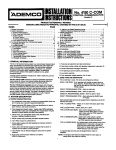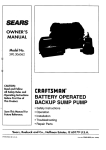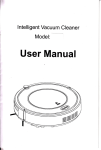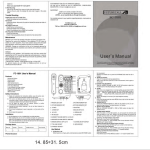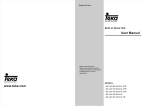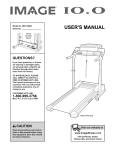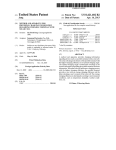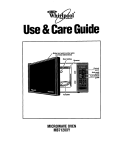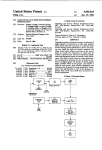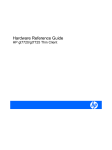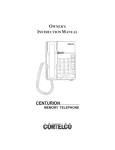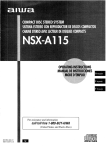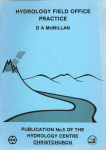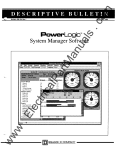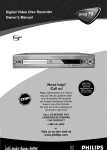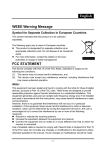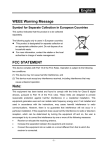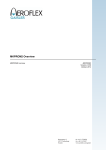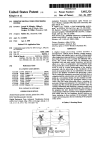Download Model 4110DL Installation Instructions - Safe-T
Transcript
4110DL INSTALLATION INSTRUCTIONS CONGRATUtATIONS on your purchase of the V’AGE 41lODL! The. purpose of these Installation Instructions is to give you a brief overview of the VANTAGE 4110DL system, and provide instructions for- installing -a basic system. Our SALES and As always, ADEMCO is there for YOU! TECHNICAL SUPPORT sfaff are eager to assist you in any way they can, so don’t hesitate to call, for any reason! East Coast Te&id Support: l-800-645-7492 (8 a.m.-6p.m. E.S.T.) West Coast Technicd Support: l-80&58-9469 (8 a.m.-j p.m. P.S.T.) PLEASE, Before you call Technical Support, be sure you have: l Checked all wiring connections and fuses. l Determined that the power supply and backup battery are supplying proper voltages. l Verified your programming information where applicable. l Noted the proper model number of this product, and the version level (if known) along with any documentation that came with the product. l Your Ademco customer number and/or company name. Having this information handy will make it easier for us to serve you quickly and effectively. Again, CONGRATULATIONS, and WELCOME I ABOARD! FOR YOUR CONVENIENCE, two easily removable Programming Forma have been included at the center of thir manual. I -2- CONTENTS Specifications ............................................... of this Alarm System ............. Canadian DCC Statement ............................ FCC Statement ............................................. Limited Warranty .......................................... General Information ......................................... Remote Programming and Control .................. : Zone Types Availabta for Selection.. ........ ....... .4 4-Digil Security Codes .................................... 5 Wiring Connections ........................................ Mounting the Console(s) ................................. 3 Programming the Security Control. ................. .9 Specific Address Programming instructions ....I 0 Testing the System ....................................... 15 Accessories ................................................. 15 GENERAL The Limitations .20 Diagrams Installing the Lo& (lf Used) .............................. 5 lnstaliing the 411 ODL Circuit Board ................. .6 Summary of Connections ................................ Programming Form ...................................... .1”3 INFORMATION that the unit can be reprogrammed many times (unlike units equipped with PROMS) and that information which has been programmed will not be lost in the event of a complete loss of power. The system provides communication capability (central station reporting, etc.) over existing telephone lines. In addition, it can be uploaded, downloaded, or controlled via your computer and Hayes Modem. This system includes an alarm output rated at 2 amps. Throughout the manual, wherever The VANTAGE (No. 4110DL) is a micropmcessorbased security control which provides up to 6 wired zones. The security control is housed in a wallmounted metal cabinet measuring 12-112. (316 mm) wide x 14-l/2” (368 mm) high x 3” (76 mm) deep, and can be used with a console equipped with a multifunction 12.key digital keypad and a numeric and fixed English status LCD display (4127). Optionally, a No. 4137 may be used or a No. 5330 Alpha Console (select for Vector device, as described in the 5330’s installation instructions) may be used with the control to provide programmable English language zone descriptors and status indications. The system may also be armed and disarmed using a keyswitch. Connections to the security control are made via a 2%terminal connector block which is used to interface to the wired loops, plug-in transformer, teiephone line, remote consoles, external alarm sounder(s), etc.The security control can be easily programmed from any of the above remote consoles. Programmed options to establish specific alarm and reporting features are stored in electrically erasable, non-volatile EEROM memory. Thii means REMOTE 16 .I7 .16 20 reference Is made to Alarm Output Ratings, they assume a fully charged battery Is connetted unless the UL rating Is stated. The battery is periodically tested and if it cannot sustain a bad, a bw battery message is displayed and can be reported to the central station. Zone Characteristics Zones l-6: Proarammabie Zones, EOLR supeGsed, N.O. or N.C. sensors, 200600 msec response (Zones l-6). fast 10 - 15 msec response optional (Zone 3). PROGRAMMING The No. 4llODL can be remotely programmed from an IBM compatible Personal Computer (PC), a Hayes Modem, and Ademco’s V-LINK@ Software Programming the No. 4llODL from a remote bcation is protected against compromise by someone attempting to defeat the system, using multi-levels of security protection: 1. Security Code Handshake: An 8-digit download ID code must be matched between the No.41 1ODL and the downloader. 2. Slte lnltiated Remote Programming: The installer or subscriber initiates the callback from the subscriber premises (by pressing MASTER CODE + # + 1). Ail parameters can then ,be downloaded via the phone lines using a personal computer. AND CONTROL 3. Station Initiated Remote Programmlng: The operator calls the sfte from your off ice to initiate the download call. The 4110DL hangs up and then calls back the PC via the preprogrammed telephone number. The unit can then be uploaded, downloaded, or controlled from your offiie. 4. Data Encryptlon: Data passed between the PC and the No. 4llODL is encrypted for security so that it is very difficult for a foreign device tapped into the phone line to take over communication and substitute system compromising information. -3- Equlpment Required At the premises: and the proper dialer reports are sent to the central station. The consoles will become .active after the download communication is terminated. The detailed operation of the download functions is covered in the installation instructions for the 413OPC Download Software Diskette. Remote Programmlng Advisory Notes: Alarm and trouble reporting may be delayed during the time that the system and the Downloader are linked to each other following a valid exchange of codes, but the proper message will get through to the Central Station after the link is broken. Keypad entries are ignored during the time interval stated above.’ A copy of the program downloaded may be produced from the IBM PC compatible computer, using the product’s internal report generator, when an optional printer is connected (consult your PC manual for proper printer and connec‘tions). Program Download Time-Less than 45 seconds for a complete program. 4110DL and console At the Installer’s &flce/home: l An IBM PC compatible computer, a Hayes brand Smartmodem 1200 (Level 1.2 or higher external or Level 1.1 or higher internal style), No. 4130PC Downloading Software Diskette (Rev. 1.78 or higher), and ap propriate interconnecting cables. l Programmlng: The downloading system can perform many functions when in communication with the control unit. Besides uploading and downloading, the status of the system can be observed and various commands can be initiated. Notes: After the 411 ODL and the PC have established valid communication, each console on the system will become inactive and will display “Cc’. The 411ODL, however, will still be scanning its zones and looking for alanns. lf an alarm does occur, after communication is broken off, alarms are sounded ZONE TYPES AVAILABLE For each zone used, one of the following zone types must be selected: 0. Zone Disabled 1. EnttyiExlt Burglary. Assigned to sensor6 on dOOE tMiigh which entry and exit will normally take place when the system is armed. 2. not used 3. Perimeter Burglary. Normally assigned to all aen6or6 on exterior doors and windows requiring instant alarm. 4. Interior, Follower. Delayed alarm only if the Entry/Exit zone is faulted first; otherwise, produces an instant alarm. Assigned to zone covering an area such as a foyer or lobby through which one must pass upon entry to reach the keypad to disarm the system. Designed to provide instant intrusion alarm in the event an intruder hides on the promises prior to the system being armed or gains access to the premises through an unprotected area. 5. Trouble by Day/Alarm by Nlght. Can be assigned to a zone which contains a foil-protecteddoororwirbdow(6ucha6ina6tore),ortoa zone covering a %ensitiie area such as a stock room, drug supply room, etc., or other controlled access area where immediate notification of an FOR SELECTION 6. 7. 8. 9. entry is desired. During the disarmed state (day), the system will provide latched Console annunciation (and central station report, it desired) of opening6 or troubles (such as sensor malfunctions or foil breaks). During the armed state (night), violation6will initiate an alarm. 24-hour Silent Alarm. This type generally assigned to a zone containing an Emergency button that is designed to initiate an alarm report to the Central Station, but which produces no local diilays or alarm sounds. 24-hour Audlble Alarm. This type also assigned to a zone containing an Emergency button, but which will initiate an audible alarm in addition to an alanrr report to the Central Station. 24-hour Auxlllary Alarm (Console sounder only). This type assigned to a zone containing a button for use in personal emergencies, or to a zone containing monitoring devices such as water sensors, temperature sensors, etc. Designed to initiate an alarm report to the Central Station and only provides %onsole warning sounds and Wmdispiays. . Supervlsed Fire (alarm on shoWtrouble on open). Fire zone may not be bypassed. Only usable on Zone 5 or Console Panic. -4- f? / . 41DIGIT SECURITY Master Security Code: to three secondary codes; it can also be USedto remove all Secondary Code6 from the System (individually). ’ Secondary security code6 are assigned by Master Code as follows: Master Code + CODE key + User # (2 - 4) + Secondary Code The system will emit a single beep when each secondary code ha6 been successfully entered. Note: When a secondary code Is inadvertently repeated for different users, or one user’s code is another’s dUre66 code, the lower user number will take priority. Individual secondary security codes can be deleted by user #l (with Master Code) as follows: Master Code + CODE key + User # (2 - 4) Note: All security codes, master and Secondary, permit access to the system for arming, disarming, etc. The installer programs tt&.Master Code initially as part of the programming procedure (see “Programming the Security Control”). The Master code petit6 re-entry into the programming mode and also allows access to the normal functions of the system. [ 1[][ J[ ] Master Code (User #l), assigned during programming. Installer exits programming mode with: ‘98 (prevents re-entry into programming mode with Master code). ‘99 (allow6 re-entry into programming mode with Master code). By exiting with ‘98, the only method of getting back into the programming mode from the console is to completely depower the system and follow the procedure noted in the section on “Programming the Security Control’. The Master security code can be USedto assign up INSTALLING CODES THE LOCK (IF USED) (The cabinet can be closed and secured without a lock by using 2 screws in the covets edge.) Use Ademco No. P3422 Cam Lock and No. P3422-1 Push-On Clip (Retainer Clip). 1. Remove the cabinet cover. It is easily removable for servicing and is easily reinstalled. 2. Remove the lock knockout from the control cabinet cover. Insert the key into the lock. Position the lock in the hole making certain that the latch will make contact with the latch bracket when the door is closed. 3. While holding the lock steady, insert the retainer clip into the retainer slots. Position clip as illustrated to facilitate easy removal. -5- r .-_d_-_ ~-- Note: BEFORE MOUNllNG THE CIRCUlT BOARD, be sure to remove the appropriate metal knockout6 from the cabinet. DO NOT AITEMPT TO REMOVETHE KNOCKOUTSAFTER THE CIRCUIT’BOARD HAS BEEN INSTALLED. INSTALLING 1. Hang two long mounting clip6 (provided) on the raised cabinet tabs (see lower detail side view at right). 2. Insert the top of the circuit board into the Slot6 at the top of the cabinet. Make sure that the board rests on the Correct NW (SW the Up per detail side view at right). 3. Swing the base of the board into the mounting clips and secure the board to the cabinet with the accompanying screws (as illustrated in tower detail). THE 4110DL CIRCUIT BOARD DETAIL SIDE VIEW OF BOARDS INSERTED INTO SLOTS I WIRING CONNECTIONS (See Summary of Connections IMPORTANT: : Dlagram) Do not connect the battery, or plug In the AC transformer, until all other wlrlng connectlons have been completed. Groundlng the System Terminal 21 is the earth ground connection point. In order for the protective device6 in this product to be effective, the designated temrinal must be terminated in a good earth ground. The following are examples of good earth gmUnd6 available at most installations: Metal cold water plpe: Use a non-corrosive metal strap firmly secured to the pipe to which the lead is electrically connected and secured. AC power outlet ground: Available from 3-prong, 125 VAC power outlets only. To test the integrity of the ground terminal, use a 3-wire circuit tester with neon lamp indicators, such as the UL Listed Ideal Model 61-035, or equivalent, available at most electrical supply Stores. TERMINALS 1 & 2: AC Input from No. 1321TTF2 okra-in transformer, in U.S.A. (16.5 VAC, 25VA) NOTE: In Canadian installations, a 1321CN transfoner must be Used. 3: Alarm relay output(+), 12 VDC, 2.OA maximum (600 rnA max. Alarm plus Aux. Power, for UL usage). 4: Alann Output / Auxiliary Power / Fire / Console /O%$al Keyswitch (BtACK lead) Ground (-) 5: 6: 7: 8: 9: 10: 11: 12: 13: 14: 15: 16: 17: 18: 19: 20: 21: Zone 4 Zone 5 Zones 5 and 6 Return. Zone 6 Handset (TIP). Handset (RING). Incoming Phone Line (TIP). Incoming Phone Line (RING). EARTH GROUND (a proper earth ground must be provided to protect the system from lightn/ng and electrostatic discharge damage). t Home run each console. Use no more than 220 of #22 wire or 550’ of #18 wire. Warning: To prevent the risk of electrical Shock, disconnect the telephone line at the Telco jack before servicing the unit. Auxiliary / Fire / Console / Optional Keyswitch (RED) Power. +12 VDC at 500 naA max. t. Data In from Console / Optional KeySWitCh (GREEN)*. Data Out to Console / Optional Keyswitch (YELLOW)*. Zone 1. (When Zones are used, a 1,000 Ohm EOLR should be wired between the farthest sensor connected to the zone terminal and the tow side of the zone.) Zones 1 and 2 Return. Zone 2 Zone 3 Zones 3 and 4 Return. MOUNTING RED LEAD: Battery(+). When AC is present, 13.8 VDC is being developed to recharge a gel lead acid battery and when AC is absent, 12 VDC current is drawn from the battery. Battery lead reversal will Mow the battery .fuse. BLACK LEAD:Battery (-). THE 4127 CONSOLE(S) 4. Pass the interface wiring through the opening in the backplate and then mount the backplate to the wall surface with screws. 5. Splice the interface wiring to the console wires. InSulated SOlderleSS Wire splices (such a6 Ademco No. 311) may be USedfor splicing. 6. Attach the main body of the console to the wallmounted backplate. The console is property attached when it is Screwed to the backplate by top and bottom screws. 1. Separate the console from its backplate by removal of the two screws on the top and bottom edges. 2. Use the backplate to mark the positions on the wall for the screw mounting hole6 and the cutout for the interface wiring. Use wall anchor6 tot the screws and make the cut-out in the wall no larger than indicated on the template. The backplate is designed to be directly mounted to either a single or double gang electrical box. Pull the interface wiring in the wall through the cut-out. -7- ‘I I I I I I ! c -8- PROGRAMMING *HE GE&STY Installer options are stored in non-removable,electrically erasable, non-volatile EEROM memory.’ These optiins must be programmedfor the particular installation to establish its specifii alam, and reportingfeatures. The searrity control may be programmed from a remote console. When programming, the field number will be displayed on the LCD display: also, each entry is displayed as it is keyed in. After programming, values that have been entered in each field can be reviewed and, if necessary, modified. *Note: lt is possible to program the system at any time - even at the installer’s premises prior to the actual installation. Simply apply power tetiporarily to the control and then program the unit as desired. When programming from the console, note the following: 1. Enter the Programming mode by simultaneously depressing the [‘I and [#I keys wlthln 50 CONTROL The following is a description of commands necessary for programming: FUNCTION PROCEDURE ENTER PROGRAMMING MODE: 1. POWER UP, then depress r)and [#] simultaneously within 50 seconds of powering up. OR 2. Initially, Key: 4 + 1 + 1 + 0 plus CODE key + 0. OR 3. After Master Code is programmed, key: Nl@ter Code + CODE key + 0. (If ‘98 was used to exit previously, method 1 above must be used to ente! the program mode again.) l 99 (allows m-entry to proE~RAMMING grammingmode via Type 3 MODE: entry method above) ‘98 (inhibits re-entry to programmingmode via Type 3 entry method) ADVANCE TO FIELD: r] + ADDRESS (e.g. 21, 35, 52, etc.). PROGRAMFIELD: r] + ADDRESS, followed by data entries. ERASE FIELDS: [‘I + ADDRESS + r] (only applies to Addresses 40 thn, 43 and 94.) READ FIELD: [nr] + ADDRESS SPECIAL MESSAGES oc= OPEN ClRCUlT (no communicationbetween the Console and the Ccntfcl). EE = ERROR (programentry mistake, re-enter the data). After powering up, AC, dl (disabled) and NOT READY will be displayed after approximately 4 seconds.Thii will reverl to READY in appx. 1 minute, which allows PIRS, etc. to stabilize. To bypass this delay, press: # + 0. seconds after power Is applied to the Control, or subsequently by keying the code 4 + 1 + 1 + 0 followed by depression of CODE + 0 keys. Once a Master code is programmed, use ii instead of 4110 to gain access to the Programming mode. If the Programming mode was exci&$f previously using a ‘96. it will prevent entry into the Programming mode by the use of the Master Code + CODE + 0. 2. Immediately following entry into the program mode, 20 will be displayed. (If a 5330 console is used, 00 will be displayed. Enter l 20 to access the programming start point). Following the above display, the system is ready to accept entries for Address 20. To program a data field, key r) plus Address (for example, ‘21). then make the required entry. To simply review a data field, key [#I plus Address. 3. When a data field has been completely programmed, the console will normally “beep” three times and then automatically proceed to, and display, the next data field address to be programmed (if not, key r] plus the address of the next field to ba programmed). 4. If the number of digits that you enter in the data field is less than the maximum permitted (for example, phone number), then the console will display the last data entered. To proceed, the next data field address to be programmed must then be entered (for example, ‘42). 5. If an address is improperly entered, the console will display EE. Simply m-enter or # plus the number. l -9- Note: The followlng progremmlng InformatIon Shows Factory Default Settlngs withln brackets: [ ] SYSTEM ARMING (*20-•23) MASTER SECURITY *20 ‘23 ZONE ‘29 l 30 CODE RESPONSE PROGRAMMING l 29-•39 ‘40 FIRE TIMEOUT DISABLE [0 ] Enter 1 to disable the sounder timeout for fire or 0 to enable ft. ALARM BELL TIMEOUT ‘41 20 not used 3= PERIMETER, Burglary 4= INTERIOR, FOLLOWER, Burglary 5= TROUBLE BY DAY/ALARM BY NIGHT, Burglary 6= 24 Hr (silent) 7= 24 Hr (Audtte) 8=24Hr (Aux) S= FIRE, Fields ‘35 8 l 37 onty ‘32 RESPONSE TYPE FOR ZONE 2 [4 ] Enter 1 dlltl ‘33 RESPONSE TYPE [3 ] Enter 1 digil RESPONSE TYPE [3 ] Enter 1 diit RESPONSE TYPE [9 ] Enter 1 digit, RESPONSE TYPE ‘34 l 35 ‘36 l 37 FOR ZONE PRIMARY PHONE No. ‘42 Enter up to 12 digits, g-9. Do not fill unused spaces. End field by entering ‘42 lf not filled. To clear entries from field, press ‘41’. Note: Back-up reporting (8 calls are made to the secondary phone number if no acknowledgment is received after 8 attempts to the primary number) is automatic only if there is a secondary phone number. SECONDARY PHONE No. I ,P ‘\ f’ ~ltIl~IIHIHIXltI See above. End field by entering ‘43 if not filled. To clear entries from field, press l 42*. ‘43 SUBSCRIBER ACCT. No. 1~51[15lI~511~51 Enter digits O-9; #+l l=B; #+12=C; #+13=D; #+14=E; or #+15=F. Enter as the fourth digit if a 3 digit acct no. (for 3+1 dialer reporting format) is used. Enter 0 as the first digit of a 4-digit acct no. for nos. OOOO0999. End field by entering ‘44 if only 3 digits are used. To clear entries from field, press ‘43’. 1 l FOR ZONE 3 FOR ZONE 4 FOR ZONE 5 FOR ZONE 6 FOR ZONE 7 ‘44 REPORT FORMAT [ 0 ] Determine which format is to be used to report to central station. Enter 1 digit. 0 = 3+1; 4+1 ADEMCO US Standard 1 = 3+1; 4+1 Radionics Standard 2 = 4+2 ADEMCO Lo Speed Standard 3 = 4+2 Radionics Standard 6 = 4+2 ADEMCO Express 7 = Ademco Contacf ID Reporting 8 = 3+1; 4+1 ADEMCO Lo Speed Xpanded 9 = 3+1; 4+1 Radionics Expanded (Enter as the 4th digit of ‘43 if 3+1 dialer reporting is to be used.) p ] Enter 1 digit RESPONSE TYPE (Console Panic) [6 ] Enter 1 dgit CODE InltlIHIlIPltHHltl O= Zone Disabled l= ENTRY/EXlT, Burgtary RESPONSE TYPE 11) Enter 1 digit ACCESS l for ‘31 PABX [ ] [ ] [ ] 1 ] Enter4 digits, 9-9,for each PABX digit needed to access an outside line. To skip this field, enter l . If is entered, no PABX number will be dialed and nothing will appear in this field. End field by entering ‘41 if not filled. To clear entries from field, press ‘40’. [l ] External sounder will shut off after time Jlotted. Enter 1 digit. Notim8out -0 4 minutes = 1. 8 minutes -2 12 minutes =3 Use the followlng table of zone types programming addresses ‘3%‘37 2’ ENTRY/EXIT DELAY [2 ] System will wait the time allotted before sounding alarm upon entering. Enter 1 digit. Exit delay = Entry delay plus 15 seconds O= 0 Seconds l= 20 Seconds 2= 30 Seconds 3= 45 Seconds ZONE 3 RESPONSE TIME TO OPEN ‘39 [0] 400msnominal =O 1Onisnominal =l DIALER PROGRAMMING C40-•48) position inhibits the Ambush feature. QUICK ARM ENABLE (0 ] Enter 1 for enabled or 0 for disabled KEYSWITCH ENABLE [0 ] Enter 1 for enabled or 0 for disabled FORCED. BYPASS ENABLE (0 ] Enter 1 for enabled or 0 for disabled ‘22 f”\ l 38 [411][1uO] Enter 4 digits, O-9 (entry of all 4 is mandatory). Use of a 9” in the fast ‘21 ?HE PROGRAMMING FoRMPRNTEDON PAGE13’ CAN BE“SEA fo RECORD THE DATA FORTHISINSTALLATION Only zone types 0,6,7&g applicable. l -lO- C0ntinuad on Page 11 * f-7 ‘.,, ,/ [~DEIVICO, FIELD SYSTEM PROGhAMMlNG 4110DL PROGRAMMED FUNCTION ARMiNG VALUES (!20=23) ‘20 MASTER SECURITY CODE ‘21 OUICK ARM ENABLE +Do - no, 1 D yes ‘22 KEYSWITCH ENABLE +I70 -no,1 eyes ‘23 FORCED BYPASS ENABLE +D -no,1 =yes ZONE RESPONSE FIRE TIMEOUT DISABLE ‘30 ALARM BELL TfMEOLfT ‘31 ZONE 1 RESPONSE NPE +no tt c] (*29-‘39) tno.1 =yes 0 = none; 1 P 4 min; 2 = 8 min; 3 = 12 min ZONE cl ‘32 ZONE 2 RESPONSE TYPE cl ‘33 ZONE 3 RESPONsE NPE Cl ‘34 ZONE 4 RESPONSE TYPE cl ‘35 ZONE 5 RESPONSE TYPE El ‘36 ZONE 6 RESPONSE TYPE El l 37 ZONE 7 RESPONSE TYPE l 38 EN-tFtYDElAY ‘39 ZONE 3 RESPONSE TO OPEN PROGRAMMING Enter 4 digits, O-9 clnclcl PROGRAilMlNG ‘29 DIALER FORM cl i-tq t 0 ‘ TYPES FOR PROGRAMMING FIELDS ‘31.37 0 (or undefined) I Zone Disabled 1 = ENTRY/EXIT. Burglary 2 I not used 3 - PERIMETER. Burglary 4 I INTERIOFI/FOLLOWER. Burglary 5 - TROUBLE BY DAY/ALARM BY NIGHT, Burglary 6 I 24 Hr (Silent) 7 I 24 Hr (Audible) 8 I 24 Hr (Auxiliary) 9 I FIRE (Fields ‘35 and ‘37 only) CONSOLE PANIC. Only zone types 0,6.7.8.9 applicable. 0=0sec;1=20sec;2=30&;3=45sec WiT Delay = ENTRY Delay + 15 set 0 - 4OO.ms nominal: 1 I 10 ms nominal (*40=48) ‘40 Enter 4 digits, O-9. ff fewer than 4 digits entered, exit by PABX ACCESS CODE lJclncl pressing l (and press 41, if entering next field). To clear entries from fiild, press ‘40’. ‘41 PRIMARY PHONE No. [lnnnnnnnnnnm. Do not fill unused spaces. tf fewer than 12 digits entered, exit by pressing To clear entrfes from field, press ‘41’. l Enter up to 12 digits, O-9. (and press 42, if entering next field). ‘42 nnnnnnnnnnnq Enter up to 12 digits, O-9. SECONDARY PHONE No. Do not fill unused spaces. lf fewer than 12 digits entered, exit by pressing ’ (and press 43,fl entering next field). To clear entries from field, press ‘42’. ‘43 SUBSCRIBER ACCOUNT No. Enter O-9: #+ll fdr B; #+12 for C;#+13 EIOOII for D; #+14 for E; #+15 for F. ff only 3 digits used, exit by pressing l (and press 44. if entering next field). To clear entries from field, press ‘43’. Examples: For Acct No. 1234. enter: 111 121 131 14( ‘44 For Acct No. 8234. enter: m 121 131 14( For Acct No. 123. enter: rl 121 131 1’1 Enter l as the 4th digit of ‘43 if 3+1 dialer reporting is to be used. 0 0 = 3+ t,4+ t ADEMCO Vs STANDARD 6 or undefined I 4+2 ADEMCO EXPRESS REPORTFORMAT 1 = 3+1,4+ 1 RADIONICS STANDARD 2 I 4+2 ADEMCO US STANDARD 3 = 4+2 FIADIONICSSTANDARD i? 0 ‘45 PHONE SYSTEM SELECT ‘46 SESCOAlRADlONlCS l 47 15 SEC DIALER DELAY (BURG) t 0 ‘48 24 HR TEST MESSAGE ‘ttfa~berotkrthanOor1 SELECT t 0 +I3 7 = ADEMCO CONTACT ID REPORTING 6 = 3+1,4+ t ADEMCO Vs EXPANDED 9 = 3+1,4+1 RADIONICS EXPANDED If Cent. Sta. IS NOT on a WATS line: 0 I Pulse Dial; 1 I Tone Dii ff Cent. Sta IS on a WATS line: 2 I Pulse Dii 3 I Tone Dii 0 I Radiinics (O-9, B-F reporting); 1 I SESCOA (O-9 only reporting) Select 0 for all other formats. 0 = no, 1 - yes - no, 1 I) yes (enter Test Code in field ‘64) isentered,evennumbens=sameasO;oddnumberr=S~~l. ti If a number greater then 3 is entered, the control will subtract multiples of 4 to get to the allowable Program range. 41 tODLPR 8I91 (See Instructions N6672) OVER* TO PROGRAM ALARM, SYSTEM STATUS, AND RESTORE REPORT CODES (31-74): .With a 3+1 or 4*1 Standard Format: Enter a cade ir the f.kH Box: 1-9, 0. 8, C. 0, E, or F. Enter (#+lO] for 0. [till] for B. (#+12] for C. [#+lS] for D, [#+143 for E [#+15] for F. A [0] (not (#+lO]) in the fmt box will dii a report. A [O] (mt[#+lO]) in the sewnd box will result in automatic advance to the next fiikt when programming. With an Expanded or 4+2 Format: Enter codes in both boxes (1st and 2nd digits) for l-9. 0. or B-F. as described above. A [O] (not [#+lO]) in the seccnd box will eliminate the expanded message for that report. A [0] (not [#et 01) in b@Ir boxes will disable the report. With Ademco Contact ID Reporting: Enter any digil (other than [0]) in the first box, to enable zone to report (entries in the mcund boxes will be ignored). 1A (01 (not (#+lO]) in the first box will disable the report. I Examplti: For Code 3 (Single Digit), enter: 131 Fl CODES ‘52 ZONE 2 ALARM REPORT CODE ‘53 ZONE 3 ALARM REPORT CODE l 54 ZONE 4 ALARM REPORT CODE ‘55 ZONE 5 ALARM REPORT CODE ‘56 ZONE 6 ALARM REPORT CODE ‘57 ZONE 7 ALARM REPORT CODE (console Panic) ‘56 ZONE 8 ALARM REPORT CODE (Dur-4 ‘59 ZONE 9 ALARM REPORT CODE CTemper) SYS STATUS ‘60 TROUBLE REPORT CODE III ‘61 BYPASS REPORT CODE ElII ‘62 AC LOSS REPORT CODE uu ‘63 LOW BAT REPORT CODE no l 64 TEST REPORT CODE uu ‘65 OPEN REPORT CODE I ‘66 F--j ‘\, / ‘70 ALARM RESTORE RPT CODE 2nd digit is autcmaticalty sent as the 2nd digit of the zone alarm report axie programmed in ‘51-‘59. ,j expanded or 4+2 reporting is, S6hCtWL ‘71 TROUBLE RESTORE RPT CODE nr1 ‘72 BYPASS RESTORE RPT CODE j--III-) ‘73 AC RESTORE RPT CODE III ‘74 LOW BAT RESTORE RPT CODE nrj DOWNLOAD ‘94 iloy;y INFO P;; (‘941’97) 7; ,, ,, ,, ,, ,, , Enter up to 12 digits, 9-9. Dc not fill unused spaces. ti fewer than 12 digits entered, exit fieM by pressing (and press 95, if entering next fiikl). To dear entries from fietd, press ‘94’. ‘95 ‘96 l 97 RING DET COUNT FOR DOWNLOADING 1 ] O&iiable Station tnitiated Download; 1-lO=number of rings (l-9, #+lO=10, #+ll=11. #+12=12, t&13=13, #+14=14); lS=answering machine defeat (#+15-15) INtTtALRES DOWNLOAD ID, SUBSCRIBER ACCOUNT No. FOR lNtTl4L DOWNLOAD No entry required. ZEROS ALL PROGRAM FIELDS No entry required. TO EXIT PROGRAM (‘98 or ‘99) MODE Press ‘96 or ‘99 if exiting programming, or next fiild number if continuing. r60-‘66) ttt ttt CLOSE REPORT BODE !I m 2nd digitis automatically sent as the user number if expanded or 4+2 reporting is selected. 41lODLPR &91 (See Inseuc3ons N3372) q l III ElII III IO 10 El0 IO III ElII ZONE 1 ALARM REPORT CODE CODES (*69=74) GLOBAL RESTORES FOR TROUBLE, BYPASS o-rut,1 -yes (‘51-39) ‘51 RPT CODES ‘69 121 For C&I B2 (Hexabcimal) enter: (x+ltI .REPORT RPT r[ For Code 32 (Two Digits), enter: m ALARM RESTORE ‘96 EXTTS PROGRAMMHG MODE and prevents m-entry by: Master code + Code + 0. ‘99 EXtTS PROGRAMMMG MODE and allows m-entry by: Master Cede + code + 0. f---J ‘\ i (;APEMcoJ 4110Di PROGRAMMED FUNCTION FIELD SYST.EM ARMING VALUES (‘20=23) q CIIJCI Enter 4 digits. O-9 ‘20 MASTER SEClJRtTY CODE ‘21 QUICK ARM EN&E tclo -no, 1 -yes ‘22 KEYSWITCH ENABLE +cb Iro.1 -yes ‘23 FORCED BYPASS ENABLE +I3 -no.1 -yes .ZONE RESPONSE PROGRAMMING ‘29 FIRE TlMEOUT @%BLE ‘30 ALARM BELL TtMEOUT ‘31 ZONE 1 RESPONSE TYPE ‘32’ ZONE 2 RESPONSE NPE cl ‘33 ZONE 3 RESPONSE TYPE q ‘34 ZONE 4 RESPONSE TYPE cl ‘35 ZONE 5 RESPONSE TYPE cl ‘36 ZONE 6 RESPONSE TYPE cl ‘37 ZONE 7 RESPONSE TYPE cl ‘38 ENTRY DELAY ‘39 ZONE 3 RESPONSE DIALER ‘40 ‘42 l 43 ‘44 +I20 tt [7 (‘29=39) -no,1 -yes = 4 min; 2 I 8 min; 3 = 12 min O-none;1 ZONE cl +-tq TO OPEN + q PROGRAMMING TYPES CONSOLE PANIC. Only zone types 0,6.7.6,9 FIELDS ‘31-37 applicable. O=Osec;1-2Osec;2-3Osec;3=45sec EXlTDelay=ENTRYDelay+15sec 0 I 400 ms nominal; l-10 ms nominal (*40-•48) l Enter 4 digits, O-9. If fewer than 4 digits entered, exit by cl000 (and press 41,. if entering next field). To dear entries from field. press ‘40’. PRlMARY PHONE No. nnnnnnnnnnnn Do not fill unused spaces. tf fewer than 12 digits entered, exit by pressing To clear entries from field, press ‘41’. l Enter up to 12 digits, O-9. (and press 42, if entering next field). mnnnnrinnnnnr] SECONDARY PHONE No. Do not fill unused spaces. If fewer than 12 digits entered, exit by pressing To dear entries from field, press ‘42’. l Enter up to 12 digits, o-9. (and press 43. ii entering nexl fiild). SUBSCRIBER AkCOlJNT No. 0000 for D; fit4 for E; #+15 for F. If only 3 digits used, exit by pressing clear entries from field, press ‘43’. REPORT FORMAT Enter cl l ++ c]tf ‘45 PHONE SYSTEM SELECT ‘46 SESCOAIRADIONICS ‘47 15 SEC DIALER DELAY (BURG) + 0 ‘46 24 HR TEST MESSAGE SELECT + [7 +clo l Enter O-9; #+ll for B; #+12 for C$+13 (and press 44. if entering next field). To as the 4th digit of l 43 if 3+1 dialer reporting is to be used. 0 si 3+1.4+1 ADEMCO W STANDARD 1 - 3+1.4+1 RADIONICS STANDARD 2 5 4+2 ADEMCO lJS STANDARD 3 s 4+2 RADIONICS STANDARD e FOR PROGRAMMING 0 (or undefined) I Zone Disabled 1 t ENTRY/EXIT, Burglary 2 - nor used 3 I PERIMETER. Burglary 4 - INTERIOWFOLLOWER. Burglary 5 - TROUBLE BY DAYIAlARM BY NlGHT, Burglary 6 = 24 Hr (Silent) 7 = 24 Hr (Audible) 8 I 24 Hr (Auxiliary) 9 = FIRE (Fields ‘35 and 37 only) PABX ACCESS CODE pressing ‘41 FORM PROGRAMMING 6 or undefined - 4+2 ADEMCO EXPRESS 7 P ADEMCO CONTACT ID REPORTfNG 6 - 3+1,4+1 ADEMCO US EXPANDED 9 - 3+1,4+1 RADlOfWS EXPANDED Cent.Sta ISNOTona WATS tine: II Cent. Sfa Is on a WATS lie: 0 -PulseDi 1 -ToneDi 2 I Pulse Dial, 3 I Tone Dial 0 = Radionics (O-9. B-F reporting); 1 = SESCOA (O-9 only reporting) Select 0 for all other formats. 0 - no, 1 = yes = no, 1 = yes (enter Test Code in field ‘64) tIfanumber~~Oorlisentered.evennumbers=sameesO;oddnumbers=s~~l. lt If a number greater ti 3 is entered, Um conti 4110DLPR 8/91 (Sea Instructions N6672) will subfracf multiples of 4 fo gel to the allowable program range. OVER* TO PROGRAM ALARM, SYSTEM STATUS, AND RESTORE REPORT CODES (-51.•74): With a 3+1 or 4+1 Standard Format: Enter a code ir the first box: l-9, 0. B, C, D, E, or F. Enter [#+lO] for 0. (Ikll] for B, [#+12] for C, [#+13] for D. [#+14] for E [#+15] for F. A [0] (not [#+lO]) in the first box will disable a report. A [0] (not [#+lO]) in the second box will resutt in automatic advance to the next field when programming. With an Expanded or 4+2 Format: Enter codes in both boxes (1st and 2nd digits) for 1-9, 0. or B-F. as described above. A [O] (not (#+lO]) in the second box will eliminate the 8xpanded message for that report A [O] (not [#cl 01) in both boxes will disable the report. Wfth Ademco Contact ID Reporting: Enter any digit (other than IO]) in the firs? box, to enable zone to report (entries in the second boxes will be ignored). IA [Ol (not (#+lOl) in the firstbox will disable the report. 1 Examples: For Code S (Single Digit), enter:. 13) Fl For Code 32 (Two Digits). enter: 131 For Cods 82 (Hexadecimal) enters m*+r ALARM REPORT CODES RESTORE ‘69 RPT CODES (‘69=-I) GLOBAL RESTORES FOR TROUBLE, BYPASS O-no.1 cl =yes l 70 ALARM RESTORE RPT CODE I 2nd digit is automatically sent as the 2nd digit of the zone alarm report code programmed in ‘51-‘59. if expanded or 4+2 reporting is selecled. ‘71 TROUBLE RESTORE RPT CODE r/r] ‘72 BYPASS RESTORE RPT CODE I-IT] ‘73 AC RESTORE RPT CODE ElII ‘74 LOW BAT RESTORE RPT CODE rIrI DOWNLOAD ‘94 INFO (‘94=97) DOWNLOAD PHONE No. clclclclclclnnclclun Enter uo to 12 dioits. O-9. Do not fill unused soaces. 121 12) U feweithan 12 digi& entered, exit fietd by pressing (and press 95, if entering next fiiki). To clear entries from field. press ‘94’. (*51=59) l ‘51 ZONE 1 ALARM REPORT CODE ‘52 ZONE 2 ALARM REPORTCODE ‘53 ZONE 3 ALARM REPORT CODE ‘54 ZONE 4 ALARM REPORT CODE ‘55 ZONE 5 ALARM REPORT CODE ‘56 ZONE 6 ALARM REPORT CODE ‘97 ‘57 ZONE 7 ALARM REPORT CODE (Console Park) TO EXIT PROGRAM (*98 or l 99) ‘56 ZONE 8 ALARM REPORT CODE Press ‘96 or l 99 if exiting programming, or next fiitci number if continuing. (Duress) ‘95 ‘96 RtNG DETCOlJNTFOR DOWNLOADING I[ O-Disable Station Initiated Download; i-t&number of rings (I-9, #+ltklO. #+ll=ll. U+t2=12, #+l3-13, #+14-14); %-answering machine defeat (#+15-15) INtTlAUZES DOWNLOAD ID, SUBSCRIBER ACCOUNT No. FOR INITIAL DOWNLOAD No entry required. ZEROS ALL PROGRAM FIELDS No entry required. MODE ZONE 9 ALARM REPORT CODE WwN 098 EXITS PROGRAMMING MODE and prevents re-enty by: Master Code + Code + 0. SYS STATUS ‘99 EXITS PROGRAMMING MODE and a/kws re-entry by: Master Code + code + 0. ‘60 TROUBLE REPORT CODE ‘61 BYPASS REPORT CODE ‘62 AC LOSS REPORT CODE ‘63 LOW BAT REPORT CODE ‘64 TEST REPORT CODE ‘65 OPEN REPORT CODE l 66 4llODLPR RPT CODES CLOSE REPORT CODE m 2nd diiit is automaticalty sent as the user number if expanded or 4+2 reporting is selected. 8191 (See Instructions N5672) Ademco Conlat( ID Reporting takes the following format: CCCC Q EEE GG ZZZ where: CCCC = Customer (subscriber) ID 0 t Event oualifier. where: E = r&w iveni and R = restore EEE = Event code (3 hexadecimal digits) NOTE: -plebe list of event c&es. refer to the centml officf~ receiver manual. cij = Always 00 222 = Zone/contact ID number reporting the alarm. or user number for opeNdose reports. System status messages (AC Loss, Walk Test, etc.) mntain zeroes in the ZZZ location. * Continued from Pa9e 10 The Alarm, System Status and Restore Report Codes shown in fields -51-‘74 in the following sections may be designated to report to the central station in any of the above formats. The 3+1 and 4+1 Standard formats comprise a 3 (or 4) digit subscriber number and a single digit report c&e (e.g. Alarm, Trouble, Restore, Open, Close). The 3+1 and 4+1 Expandad formats comprise a 3 (or 4) digit subscriber number, and a single digit report code, followed by a second linewhere the report code is repeated 3 (or 4) times and tollowed by another number (normally the tone number) or user ID related to that report The 4+2 formaW comprise a 4 digit subscriber number and single digit report code, immediitely followed by the zone number (normally) or user ID. The Ademco Contsd 10 Reporting formal comprises a 4 digit subscriber number, 1 diiit ewnt qualifier (-new- or ‘restore-). 3 digit event code, 2,drgit ‘OO’.and 3 digit zone. contact ID. user. or system status numtqr. 4+2 3*114*i 3*114*1 Sss(S) A ssso T Trouble SBSS) A BSSSAZ A&Aj Z sss(S) T Jlwlt SBSS Tt ‘45 S=W B AC Loss SWS) E !S&S; E E=(E) AC l 46 =m sss(S) L LLL(L) LB L l 47 Cbm sss(S) c sssscu Test Ssso G -Gg sss(s) RA -RA LoBat Res. - E:; LLEI 0 C + Rrt R& RAAC RLLB PROGRAM ALARM, SYSTEM STATUS, AND RESTORE REPORT CODES (Fields l 51-‘74): [#+ll] Tamper for 8, [#+12] for C, [#+13] for D. [#+14] tor E, k (01 (mr[#+lO]) in the fkstbox will disable a report. A [0] (not[#+lO]) in the second box will resutt in automatic advance to the next field when programming. A, RLLe Wlth an Expanded or 4+2 Format: Enter codes in both boxes (1st and 2nd digits) for l-9,0, or B-F, as described above. IA [O] (not [#+lO]) in the second box will eliminate the exIpanded message for that report. 1A [0] (not (#+l 0]) in both boxes will disable the report. Wlth Ademco Contact ID Reportlng: Enter- any digit (other than [0]) in the first box. to enable zone to report This is an ‘enabling” code only and is disregarded in the actual repomng to the central offtce. Entnes n the second 19.; wiUpig;Fd. ’ ’ ’ p / A 0 not #+lO in the firstbox will disable the re OR. = Subscriber ID = Atam Code-l st digit = Ty&ally Zone Numbef-2nd digit I %ublewCode (1st 6 2nd digik) = Bypass Code (1st & 2nd digits) = AC Wss Code (1st 6 2nd digits) s Low Battery Code( 1st 6 2nd digits) i Open Code-1st Diiit = Cbse Code-l st Dioit I User Number (1st i 2nd digits) =TestCode(lstb2nddigits) P Restore Coda (Alarm)lst 6 2nd digits = Restore Code (Trbl)lst 6 2nd digits = Restore code &.k)l St 6 2nd digits = Restore Code (AC)lst 6 2nd digik = Restore Code (Bal)lst 6 2nd digits ‘Zone numbers for: !A[: 12 hrs after control TO BSSS Rgb ft [ 0 ] is programmed or downloaded, and every 24 hrs thereafter. Trouble Res. 0ypass la. [ 0 ] If enabled, code proiammed for field ‘64 will be sent approximately SSSSRZ Restore SELECT 15 SECOND DELAY FOR BURd l=YES O=NO 24 HR TEST MES;AyES[ 0 ] O=NO s=ue SBSS ou when?: SSS or SSSS A z SESCOAlRADlONlCS EAC sss(S)O [ 0 ] 0 = Radionics (O-9,B-F reporting) 1 = SESCOA (O-9only reporting) ‘48 ssss SELECT Enter 1 digit. If Central Station Rcvr is not on WATS line: 1 = Tone Dial 0 = Pulse Diil If Central Station Rcvr is on WATS line: 2 = Pulse Dial 3 = Tone Dial SBSS Bb BYpasS AC Restore PHONE SYSTEM See examples on programming form. ALARM ‘51 ‘52 ‘53 ‘54 =7 09 ~9 ‘55 -71- REPORT CODES (*51-•59) ZONE 1 ALARM RPT CODE IOIPI ZONE 2 to1IO1 ALARM RPT CODE ZONE 3 ALARM RPT CODE 101101 ZONE 4 ALARM RPT CODE ZONE 5 ALARM [O I IO I RPT CODE 10II0 I ZONE 6 ALARM RPT CODE l S6 DOWNLOAD INFORMATlON (%4-•97) DWNLD PHONE NUMBR tolP1 l s7 l 94 ZONE 7 ALARM RPT CODE CONSOLE PANIC 10 I IO 1 ;;t’JEE~SALARM RPT CODE l S8 ZONE 9 ALARM TAMPER '59 12 digits: O-9. Do not fill unused spaces. End field by entering lf not filled. To clear entries from field, press ‘94’. RPT CODE STATUS REPORT CODES (*60-•66) '96 (See box above field ‘51) '60 TROUBLE RPT CODE 10 I D 1 BYPASS RPT CODE 10 I IO I AC LOSS RPT CODE l 61 '62 l 10I P I l 63 LO BAi RPT CODE TEST RPT CODE PIP1 OPEN RPT CODE [0 ] (2nd digit = User #) CLOSE RPT CODE [0)(2nd digit=User#) l 65 l 66 RESTORE REPORT RING DETECTION COUNT FOR DOWNLOADING 0 I disable station initiated dwnld 101 97 INITIALIZES DOWNLOAD ID AND SUBSCRIBER ACCT. No. FOR DOWNLOADING (No entry required) ZEROES ALL PGM FLDS (No entry required) Press ‘98 or l 99 lf exiting programming, or next Field No. if continuing. TO EXIT PROGRAM MODE (*98 or l 99) l 98 EXITS PROGRAMMING MODE and prevents m-entry by: Master code + code + 0 EXITS PROGRAMMING MODE '99 and allows m-entry by: Master code + code + 0 ~oltol l 64 . l-14 = # of rings 15= answering machine defeat 10I roI SYSTEM r) l l 96 to1toI ~I~I~I1I~III~I~1~I~I~I~l~~~~~~ CODES (*69-•74) (See box above field ‘51) 1'69 l 70 GLOBAL RESTORES FOR TROUBLE, BYPASS [O] Enter 1 for enabled or 0 for disabled ALARM RESTORE RPT CODE 1ST DIGIT r)‘>. .’ [0](2nd diiit normally zone #) ,Whenset to 0, all restores are disabled. The 2nd digft of an alarm restore 2 digif report is the same as the 2nd djglt of the alamr report being restored as found in fields ‘51 - ‘59. '71 TROUBLE RESTORE RPT CODE [0] [O] If the 1st digit is set to 0, reporting is disabled. Trouble restore is reported only ff a//troubles in the system are restored, if field '69 is enabled. '72 BYPASS RESTORE RPT CODE [0] [O] If the 1st digit is set to 0, reporting is disabled. '73 '74 AC RESTORE RPT CODE $;O\e; the 1st digii is set to 0, reporting is LO BAT RESTORE RPT CODE [Ol [Oj If the 1st digif is set to 0, reporting is disabled. -12- 411 ODL PROGRAMMING a FIELD SYSTEM PROGRAMMED FUNCTION ARMING VALUES (*20=23) q nuu MASTER SECURti l 21 OUICK ARM ENABLE +uo - no. 1 = yes ‘22 KEYSWITCH ENABLE too Ino. =yes ‘23 FORCED BYPASS ENABLE +I30 =no.l =yes RESPONSE CODE Enter 4 digits, O-9 l 20 ZONE PROGRAMMING ‘29 FIRE TIMEOUT DISABLE ‘30 ALARM BELL TIMEOUT l 31 ZONE 1 RESPONSE TYPE r-l ‘32 ZONE 2 RESPONSE TYPE q ‘33 ZONE 3 RESPONSE TYPE III ‘34 ZONE 4 RESPONSE TYPE El ‘35 ZONE 5 RESPONSE TYPE cl ‘36 ZONE 6 RESPONSE TYPE l 37 ZONE 7 RESPONSE TYPE ‘38 ENTRY DELAY ‘39 ZONE 3 RESPONSE TO OPEN t DIALER ‘40 FORM +uo (‘29=39) =no.l =yes - 4 min; 2 = 8 min; 3 - 12 min tt q O=none;t q q ZONE TYPES FOR PROGRAMMING FIELDS ‘31-37 0 (or undefined) - Zone Disabled 1 = ENTRY/U(lT, Burglary 2 - nor used 3 = PERIMETER. Burglary 4 = INTERIOWFOLLOWER, Burglary 5 - TROUBLE BY DAY/ALARM BY NIGHT. Burglary 6 - 24 Hr (Silent) 7 I 24 Hr (Audible) 8 - 24 Hr (Auxiliary) = FIRE (Relds ‘36 and ‘37 only) CONSOLE PANIC. Only zone types 0,6,7,8,9 applicable. ++a o-osec:l-2Dsec;2=3Osec;3-46sec PROGRAMMING q EXIT Delay = ENTRY D&v + 15 set 0 I 400 ms nominal; 1 = 10msnominal (+40=48) q uuo Enter 4 diiits. O-9. ff fewer than 4 digits entered, exit by PABX ACCESS CODE pressing (and press 41, if entering next field). To dear entries from field, press ‘40’. l l 42 ‘43 PRIMARY PHONE No. nnnnnnnnnnnrj DO not fill unused spaces. If fewer than 12 digits entered, exit by pressing To clear entries from fiekd. Dress ‘41’. . l Enter up to 12 digits. O-9. (and press 42, if entering next field). SECONDARY PHONE No. rnnnnnnnnnnm DO not fill unused spaces. If fewer than 12 digits entered, exit by pressing TO clear entries from field. .Dress ‘42’. l Enter up to 12 digits, O-9. (and press 43, if entering next field). Enter D-9: Ikll for B; #+12 for C,#+13 SUBSCRIBER ACCOUNT No. 1IIoII for D; #+14 for E: #+lS for F. If only 3 digits used, exit by pressing (and press 44. if entering next field). To clear entries from field, press ‘43’. Exemples: For Aat No. 1224. enter: m 121 131 141 l For Acct No. 8234. enter: 1*+‘11 For Acct No. 123. enter: [Tf 131 )4) 121 131 71 q Enter ’ as the 4th diiit of ‘43 if 3+1 dialer reporting is to be used. 0 = 3+1.4+1 ADEMCO L/S STANDARD 6 or undafinad = 4+2 ADEMCO EXPRESS t = 3+1. &*t RADIONICSSTANDARD 7 = ADEMCO CONTACT ID REPORTING 2 = 4+2 ADEMCO IJS STANDARD 9 = 3+1,4+1 ADEMCO L/S EXPANDED 9 = 3+1,4+1 RADIONICS EXPANDED 3 = 4+2 RADIONICSSTANDARD ‘44 REPORT FORMAT ‘45 PHONE SYSTEM SELECT ‘46 SESCOAmADlONlCS ‘47 15 SEC DIALER DELAY (BURG) t [7 ‘48 24 HR TEST MESSAGE tIfanumbarotharthanOor1 121 SELECT fl oil t q +Uo CentSta ISNOTona WATS line: tiCent.StaB on aWATSlii: 0 -PulseDial; 1 -ToneDii 2=PulseDii,3-ToneDial 0 I Radionics (D-9. B-F reporting); 1 = SESCOA (D-9 only reporting) Select 0 for ail other formata. 0 = no, 1 I yes I no, 1 I yes (enter Test Code in field ‘64) ieentered.~numben~same~O;oddnU~=~es 1. ti If a number greatar than 3 is entarad. the control will sub@& mulplas of 4 to get to UW atlowabla program ran@. -13- OVER* RESTORE TO PROGRAM ALARM, SYSTEM STATUS, AND RESTORE REPORT CODES (.Sl-74): Wtth a 3+1 or 4+1 Btandard Format: Enter a code ir the first box: l-9. 0, B, C. D. E. or F. Enter [#+lO] for 0, [x+11] for B. [#+12] for C. [#+13] for D. (#+14] for E. [#+lS] for F. A [0] (not [#+l 01) in the first box will disable a report. A [0] (not [#+lO]) in the second box will result in automatic advanoe to the next field when programming. Wlth an Expmdod or 4+2 Format: Enter codes in 60th boxes (1st and 2nd digits) for 1-9. 0. or B-F. as described abow. A [O] (not [klO]) in the sea& box will eliminate the expanded message tar thal report. A IO] (nor [IklO]) in b&h boxes will disable the report. With Ademco Contact ID Reporting: Enter any digil (other than (01) in the first box, to enable zone to report (entries in the seoondboxes will be ignored). A (01 (not I#+1 01) in the fitsr box will disable the report. I Examploo: For Code 3 (Smgle Digit). enter: 131 vl For Code 12 (Two Dqim). enter: 131 REPORT CODES GLOBAL RESTORES FOR TROUBLE, BYPASS O=no,l-yes ‘71 TROUBLE RESTORE RPT CODE [a] ‘72 BYPASS RESTORE RPT CODE Ilr[ ‘73 AC RESTORE RPT CODE ElII ‘74 LOW BAT RESTORE RPT CODE Ilrl DOWNLOAD INFO ZONE 1 ALARM REPORT CODE nri ‘52 ZONE 2 ALARM REPORT CODE mr1 ‘53 ZONE 3 ALARM REPORT CODE me[ ‘54 ZONE 4 ALARM REPORT CODE nrI ‘55 ZONE 5 ALARM REPORT CODE !Ir] ‘56 ZONE 6 ALARM REPORT CODE 1lr1 ‘95 ‘96 ‘97 RING DET COUNT FOR DOWNLOADING 1 O=Diiable Station Initiated Download; 1-14=number of rings (l-9, t+lO=lO. #+ll-11. #+12=12, #+13=13, #+lol14); 1Sianswering machine defeat (#+15=15) INlTlALlZES DOWNLOAD ID, SUBSCRIBER ACCOUNT No. FOR INKLAL DOWNLOAD No entry required. ZEROS ALL PROGRAM FIELDS No entry required. Press ‘98 or ‘99 if exitii number if continuing. IIf- SYS STATUS l 80 TROUBLE REPORT CODE uu l 61 BYPASS REPORT CODE uu ‘62 AC LOSS REPORT CODE III ‘83 LOW BAT REPORT CODE nu ‘64 TEST REPORT CODE ElII ‘65 OPEN REPORT CODE Elm ‘88 (‘600’66) m CLOSE REPORT CODE I m 2nddiiit isautomatically sent as the user number if expanded or 4+2 reporting is selected. -14- MODE programming, or next field ‘98 EXlTSPROGRAMMlNGMODEand pmwnts reenbybyzMa5@rCode+Code+O. ‘99 EXITS PROGRAMMINGMODE and abws re-entryhy:MasterCofie+Code+O. r CODES (*94-*97) Enter up to 12 digits, O-9. Do not fill unused spaces. If fewer than 12 digits entered, exit field by pressing l (and press 95, if entering next field). To clear entries from field, press ‘94’. TO EXIT PROGRAM (*96 or +99) RPT ,’i ‘\ ALARM RESTORE RPT CODE I 2nd digit is automatically sent as the 2nd digii of the zone alarm report code programmed in ‘51-X9, ii expanded or 4+2 reporting is selected. (‘Si-39) MlNE 9 AlAFtM “POR;VCOD~ q ‘70 12) ‘51 ‘59 (*69-‘74) (21 For Code B2 (Hexadecimal) enter [=I ALARM ‘89 RPT CODES Q \‘., _.’ 1 I. TESTING THE 8YSiEM a 4. Check the keypad-initiatedalarm by pressing the Panic key pairs - r] and [#]. If the system has been programmed for audible emergency, the. console will emit a steady alarm sound, and ALARM and 07 will be displayed. Silence the alarm by entering the security code and pressing OFF. If the system has been programmed for silent emergency, there will be no audible alarms or displays, but a report will be sent to the central station. 5. Notify the central station that all tests are finished, and verify results with them. Note: If the battery standby capacity is exceeded during an AC power failure, the 411ODLwill automaticallv shut itself off. TO THE INSTALLER I Regular maintenance and inspection (at least annually) by the installer and frequent testing by the user are vital to continuous satisfactory operation of any alarm system. The installer should assume the responsibility of developing and offering a regular maintenanceprogram to the user as well as acquainting the user with the proper operation and limitations of the alarm system and its component parts. Recommendations must be included for a specific program of frequent testing (at least weekly) to insure the system’s proper opera. . 1tion at all times. 1 After installation is completed, the Sekurity System should be carefully tested. 1. With the System in the disarmed state, check that all zones are intact.‘It NOT READY is displayed, press the [‘I key to display the faulted zone(s). Restore faulted zone(s) if necessary, so that READY is displayed. Fault and restore every sensor individually to assure that it is being monitored by the system. 2. Enter the secuttty code and press the TEST key. The external sounder (if used) should sound for 1 second and then turn off each time a contact is faulted. A test report should be transmitted (if programmed)to the Central Station immediately. If the backup battery is discharged or missing, the external sounder will not turn on and a LOW BATTERY report will be transmitted instead of a TEST report. The keypad will beep once per minute to indicate that the system is in the Test Mode. r Alarm messages will be sent to the central station during the following tests 3 8 4. Notify them that tests will be in progress. 3. Arm the system and fault one or more zones. After 15 seconds (if optional dialer delay is selected), silence alam\ sounder(s) by entering the code and pressing OFF. Check Entry/Exit delay zones. ACCESSORIES No. 1321 /TF2 No. 1321CN BRK PA400B 16SVAC, 25VA Plug-In Transfoner (U.S.A. installations). 16SVAC, 25VA Plug-In Transformer (Canadianinstallations). Piezoelectric Alarm Sounder, 9OdBoutput (mounts in single- No. 2174-70, 4073-70. or 400570). gang bW. No. 702 No. 740 No. 411 ODLPR Tampered Single LED Remote Station (Arming/DisarmingKey switch). NOTE: obtain Lockswitch separately (Ademco No. 4116 Self-contained 20 watt Siren (indoor or outdoor). Extremely loud Piezoelectric Alarm Sounder, 122 dB output (indoor or outdoor). ProgrammingForm (Pkg of 50) BRK 1412 BRK 2412 BRK 2412TH also: Nos. 4127, 4-wire Ionization Products of Combustion Detector 4-wire Photoelectric Smoke Detector 4-wire Photoelectric Smoke Detector w/l 39F (57%) Heat Detector 4137, and 5330 (see SPECIFICATIONSon next page). -15- SPECIFICATIONS 4110DL SECURITY 12-l/2’ l.Physical: CONTROL 4127 REMOTE CONSOLE 1. Physical: 55/8’ (143mm)W (318mm)W 14-l/2’ (368mm) H 3’ (78mm) D 4-11118’ (119mm)H 718’ (22mm) D 2. Electrlcal: Voltage Input: 12V DC Current Drain: 20 mA 2. Electtlcal: VOLTAGE INPUT:185 VAC from plug-in 25 VA transformer, Ademco No. 1321ITF2, (in U.S.A.). Note: For Canadian installations, a No. 1321CN transformer must be used. RECHARGEABLE BACK-UP BATTERY:1 2V DC, 4 AH (Gel type) ALARM SOUNDER: 12V. 2.0 Amp output can drive 12V BELLS or can drive one or two 702 (series connected) self-contained 20-watt sirens. Do not connect two 702s in parallel. AUXILIARY POWER 0UTPUT:lPV DC, 500 mA max. Interrupts for smoke detector reset. Note: For UL installations, Alarm Sounder plus Auxiliary Power currents should not exceed 600mA. STANDBY TIME: 4 HRS with Auxiliary bad of 500 mA (using 4 AH battery).To determine total standby battery load, add lOOmA to total Aux. power output and remote console currents. FUSES: Battery (3A) No. 90-12 Sounder (2A) No. 90-2 3. Interface RED: GREEN: YELLOW: BLACK: 12V DC input (+) aux pwr Data Out to Control Data In from Control Ground 4-3/4‘ (121mm) H l-1/10” (28 mm) D 2. Electrlcal: Voltage Input: 12V DC Current Drain: 80 mA 3. Interface Wlrlng: RED: BLUE: 12VDe input (+) aux pwr 18VDC input from optional No 1350 or 1360 Power Pack GREEN: Data Out to Control YELLOW: Data In from Control BLACK: Ground and (-) connection from optional No. 1350 or.1360 Power Pack FORMATS SUPPORTED: Ademco Express, 10 characters/set, DTMF (TouchTone) Data Tones. 1400/2300Hz ACK. j400Hz KISSOFF Contact Wiring: 4137 REMOTE CONSOLE 1. Physlcal: 8-2/5” (213mm)W 3. Communlcatlon: Ademco n 5330 REMOTE ALPHA CONSOLE (Select Vector Device) 1. Physlcal: ID Reporting, 10 characters/se% DTMF (TouchTone) Data Tones, 1400/2300Hz ACK, 1400Hz KISSOFF Ademco Low Speed, 10 pulses/set, 1900Hz Data Tone. 1400Hz ACWKISSOFF RadlonlcsBESCOA, 20 pulses/sec,l800Hz Data Tone, 2300Hz ACKIKISSOFF Dan reporl g-9, B-F Line Seize: Double Pole Ringer Equivalence: 0.78 FCC Registration No.: AC 398U-68192-AL-E 2. Electrical: 7-3/4’ (197mm)W 4-7116’ (113mm) H l-1/4” WW D Voltage Input: 12V DC Current Drain: 105 mA 3. Interface RED: GREEN: YELLOW: BLACK: -16- Wlrlng: 12V DC input (+) aux pNr Data Out to Control Data In from Control Ground ‘i; (3 THE LIMITATIONS OF ,THIS ALARM SYSTEM While this System is an advanced design security system, it does not offer guaranteed protection against burglary, fire or other emergency. Any alarm system, whether commercial or residential, is subject to aPmpromise or failure to warn for a variety of reasons. For example: Intrusion detectors (e.g., passive infrared detectors); smoke detectors, and many other sensing devices will not work without power. Batteryoperated devices will not work without batteries, with dead batteries, or if the batteriis are not put in properly. Devices powered solely by AC will not work if their AC power supply is cut off for any reason, however briefly. A user may not be able to reach a panic or emergency button quickly enough. While smoke detectors have played a key role in reducing residential fire deaths in the United States, they may not activate or provide early warning for a variety of reasons in as many as 35% of all fires, according to data published by the Federal Emergency Management Agency. Some of the reasons smoke detectors used in conjunction with thii System may not work are as follows. Smoke detectors may have been improperly installed and positioned:Smoke detectors may not sense fires that start where smoke cannot reach the detectors, such as in chimneys, in walls, or roofs, or on the other side of closed doors. Smoke detectors also may not sense a fire on another level of a residence or building. A second floor detector, for example, may not sense a first floor or basement fire. Finally, smoke detectors have sensing limitations. No smoke detector can sense every kind of fire every time. In general, detectors may not always warn about fires caused by carelessness and safety hazards like smoking in bed, violent explosions. escaping gas, improper storage of flammable materials, overloaded electrical circuits, children playing with matches, or arson. Depending on the nature of the fire and/or location of the smoke detectors, the detector, even ff it operates as anticiiated, may not provide sufficient warning to allow all occupants to escape in time to prevent injury or death. Passive Infrared Motion Detectors can only detect intrusion within the designed ranges as diagrammed in their installation manual. Passive Infrared Detectors do not provide volumetric area protection. They do create multiple beams of protection, and intrusion can only be detected in unobstructed areas covered by those beams. They cannot detect motion or intrusion that takes place behind walls, ceilings, floors, closed doors, glass partitiins. glass doors, or windows. Mechanical tampering, masking, painting or spraying of any material on the mirrors, windows or any part of the optical system can reduce their detection ability. Passive Infrared Datecton sense changes in temperature; however, as the ambient temperature of the protected area approaches the temperature range of 90° to tSO°F. the detection performance can decrease. Alarm warning devices such as sirens, bells or horns may not alert people or wake up sleepers if they are bcated on the other side of closed or partly open doors. ff warning devices are bcated on a different level of the residence from the bedrooms, then they are fess likely to waken or alert people inside the bedrooms. Even persons who are awake may not hear the warning if the alarm is muffled by noise from a stereo, radio, air conditioner or other appliance, or by passing traffic. Finally, alarm warning devices, however bud, may not warn hearing-impaired people. : Telephone lines needed to transmit alarm signals from a premises to a central monitoring station may be out of service or temporarily out of service. Telephone lines are afso subject to compromise by sophisticated intruders. Even if the system responds to the emergency as intended. however, occupants may have insufficient time to protect themselves from the emergency situation. In the case of a monitored alarm system, authorities may not respond appropriately. This equipment, like other eledrical devices, is subject to component failure. Even though this equipment is designed to las as bng as 20 years, the electronic components could fail at any time. The mOSt common cause of an afarm system not functioning when an intrusion or fire occurs is inadequate maintenance. Thii afarm system Should be tested weakly to make sure all sensors and transmitters are working properly. The security console (and remote keypad) should be tested as well. Installing an alarm system may make the owner eligible for a bwer insurance rate, but an alarm system is not a substkute for insum-. Homeowners, property owners and renters should continue to act prudently in protecting themselves and continue tc insure their lives and property. We continue to develop new and improved protection devices. Users of alarm systems owe it to themselves and their fovea ones to learn about these developments. l l l l l l l -17- I I I CANADIAN DEPARTMENT OF COMMUNICATIONS (DOC) STATEMENT n ,\ :’ NOTICE The Canadian Department Of Communications label fddentlfiescertified equipment. Thii certifiition means thaf the equipment meets Certain t&CommWficatio~ network protective, operational and safety requirements. The IDepartment does not guarantee the equipment will operate to the users satisfaction. IBefore installing this equipment, users should ensure that it is pennfssfble to be connected to the facilities of the ilocal telecommunications company. The equipment must also be installed using an acceptable method oi ~wnnection. In some cases, the company’s inside wiring associated with a single line individual service may be #extendedby means of certified connector assembly (telephone extension cord). The customer should be aware that compliance with the above conditions may not prevent degradation of service in some situations. IRepairs to certified equipment should be made by an authorized Canadian maintenance facility designated by the supplier. Any repairs or alterations made by the user to this equipment, or equipment maffunctions. may give the :telecommunications company cause to request the user to disconnect the equipment. Users should ensure for their own protection-that the electrical ground connections of the power utility, telephone ,lines and internal metallic water pipe system, if present, are connected together. This precaution may be particularly importantin rural areas. SCautlon: User should not attempt to make such connections themselves, but should contact the appropriate ,electric inspection authority, or electrician. as appropriate. ‘The (LN) assigned to each terminal device .denotes the percentage of the total load to be connected to a telephone loop whiih is used by the device, to prevent overloading. The termination on a loop may consist of any combination of devices subjecf only to the requirement that the total of the Load Numbers of all the devices does not exceed 100. AVIS retiquette du ministlere des Communications du Canada identtfie te mat&M horMogu& Cette etiquette cerhfie We k mat&id eSt Conforme 8 certaines normes de protection, d’exptoitation et de s&urfte des reseaux de t~&OmmUni~tiOns. Le miniSt&e n’assure toutefois pas que le materiel fonctionnera a la satisfaction de IPutilisateur. AWIll d’in!Stalferce materiel, I’utilisateur doit s’assurer qu’fl est permis de le raWorder aux installations de rentreprise bcale de tel6communication. ‘Le materiel doif egalement 8tre install6 en suivant une method acceptee lde raazordement. Dans cerlains cas, les fils interieurs de l’entreprfse utilises pour un service individuel a ligne Iunique peuvent &he prolong& au moyen dun dispositif homologue de raccordement (cordon prolongateur ~telephoniqueinteme). L’abonne ne doit pas oublier qu’il est possible que la wnfortnite aux condiiions &on&es Icidessus n’ernpechent pas la degradation du service par certaines situations..Actuellement, les enterprises de t~UWImUhCatii~ ne permettent pas que l’on raccorde leur materiel aux jacks dabonnes, sauf dans les cas precis p&us par les tarrifs particuliers de ces entreprises. Les reparations de materiel homologue doivent etre effectuees pas un centre d’entretien canadien authorise d&igne par le foumisseur. La wmpagnie de tel6wmmunications peut demander a l’utilisateur de debrancher un appareil a la suite de reparations ou de modifications effectuees par l’utilisateur ou B cause de mauvais ,fonctionnement. Pour sa propre protection, l’utilisateur doif s’assurer que tous les fils de mise a la terre de la source d’energie 6lectrique, des liines tel6phoniques et des canalisations d’eau m&alliques, s’il y en a, sonf raccordes ensemble. Cette precaution est particulieremenf importante dans les regions rurales. L’utilisateur ne doit pas tenter de faire ces raccordements fui-m&me; il doif avoir rewurs A un ~Avertissement: /service dinspectfon des installations Olectriques,ou a un electrician, selon fe cas. (IC) assign6 a chaque diipositif terminal pour Bvfter toute surcharge indique le pouW?ntagede I ipeut &re raccord& a un circuit telephonique boucle utilise par ce disposffff. La terminaison du circuit boucl& peut &re wnstftuee de n’imporle quelle wmbinaison de dispositifs, pourvu que la somme des indices de charge de l’ensemble des dispositifs ne depasse pas 100. 4 I (---I / .\. -’ c---l -18- FEDERAL COMMUNICATIONS COMMISSION (FCC) STATEMENT I This equipment has been tested to FCC requirements and has been found acceptable for use. The FCC requires the folbwing statement for your information: Thii equipment generates and uses radio frequency energy and if not instatted and used property, that is. in strict accordance with the manufacturer’s instructions. may cause interference to radio and television reception. 8 has been type tested .and found to comply with the limits for aClass B computing device in accordance with the specifications in Part 15 of FCC Rules, which are designed to provide reasonable pmtection against such interference in a residential installation. However, there is no guarantee that interference will not aur in a particular installation. H this equipment does cause interference to radio or television reception, which can be determined by turning the equipment off and on, the user is encouraged to try to correct the interference by one or more of the following measures: . If using an indoor antenna, have a qualii outdoor antenna installed. . Reorient the receiving antenna until interference is reduced or eliminated. . Move the radio or television receiver away from the receiver/control. . Move the antenna leads away from any wire runs to the receiver/control. . Plug the receiver/control into a different outlet so that it and the radio or television receiver are on different branch circuits. If necessary, the user should consult the dealer or an experienced radio/television technician for additiinal suggestions. The user or installer may find the following booklet prepared by the Federal Communications Commission helpful: ‘Interference Handbook* Thii booklet is available under Stock No. 094-600-00450-7 from the U.S. Government Printing Office, Washington, DC 29402. The user shall nor make any changes or modifications to the equipment unless authorized by the Installation Instructions 01 ,’ User’s Manual. UnatihoriIed changes or modfications could void the US8r’S authority to operate the equipment. LIMITED WARRANTY Alarm Device Manufacturing Company, a Division of Pittway Corporation, and its divisions, subsidiaries and affiliates (%ellef), 165 Eileen Way, Syosset, New York 11791, warrants its products to be in conformance with its own plans and specifications and to be free from defects in materials and workmanship under normal use and service for 18 months from the date stamp control on the product or, for products not having an Ademco date stamp, for 12 months from date of original purchase unless the installation instructions or catalog sets forth a shorter period, in which case the shorter period shall apply. Seller’s obligation shall be limited to repairing or replacing, at its option, free of charge for materials or tabor. any part which is proved not in compliance with Seller’s specifications or proves defective in materials or workmanship under normal use and service. Seller shall have no obligation under this Limited Warranty or otherwise it the product is altered or improperly repaired or serviced by anyone other than Ademco factory service. For warranty service, return product transportation prepaid, to Ademco Factory Senrice, 165 Eileen Way, Syosset, New York 11791. THERE ARE NO WARRANTIES, EXPRESS OR IMPLIED. OF MERCHANTABILR-Y. OR FlTNESS FOR A PARTICULAR PURPOSE OR OTHERWISE, WHICH EXTEND BEYOND THE DESCRIPTION ON THE FACE HEREOF. IN NO CASE SHALL SELLER BE LIABLE TO ANYONE FOR ANY CONSEQUENTIAL OR INCIDENTAL DAMAGES FOR BREACH OF THIS OR ANY OTHER WARRANTY, EXPRESS OR IMPUED. OR UPON ANY OTHER BASIS OF LIABILITY WHATSOEVER. EVEN IF THE LOSS OR DAMAGE Is CAUSED BY THE SELLERS OWN NEGLfGENCE OR FAULT. Seller does not represent that its product may not be oompromised or circumvented; that the product will prevent any personal injury or property bss by burglary, robbery, fire or otherwise; or that the product will in all cases provide adequate warning or protection. Buyer understands that a property installed and maintained alarm may only reduce the risk of a burglary, robbery or fire without warning. but it is not insurance or a guarantee that such will not r%zur or that there will be no personal injury or property loss as a result. CONSEOUENTLY. SELLER SHALL HAVE NO LIABILITY FOR ANY PERSONAL INJURY, PROPERTY DAMAGE OR OTHER LOSS BASED ON A CLAIM THE PRODUCT FAILED TO GIVE WARNING. However, if Seller is held liable. whether directly or indirectly, for any bss or damage arising under this Limited Warranty or otherwise, regardless of cause or origin. Seller’s maximum iiiilii shall not in any case exceed the purchase prii of the product, which shall be the complete and exclusive remedy against Seller. Thii warranty replaces any previous warranties and is the only warranty made by Seller on this product. No increase or alteration, written or verbal, of the obligation of this Limited Warranty is authorized. AlARM DEVICE MANUFACTURING CO- ADMSC+JOFPftlWAY~TiCM 165 Eileen Way, Syosset, N5672 8191 Cqyri#tt~lWl New York 11791 UllWAYCOWORATtON Notes r ,;‘! -’
























